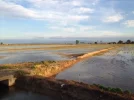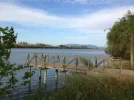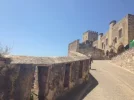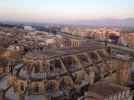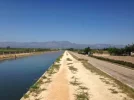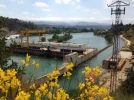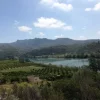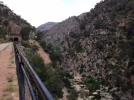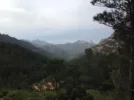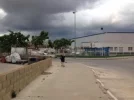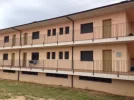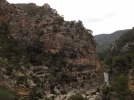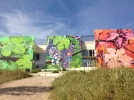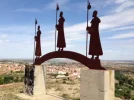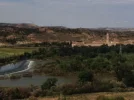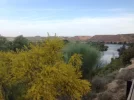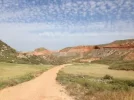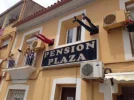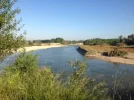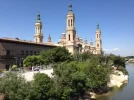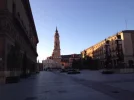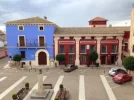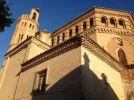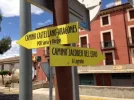My Camino 2016 involved combining several different caminos. I started in Riumar at the mouth of the Ebro, stayed with the Ruta del Ebro till two days after Zaragoza, in Gallur, where you have to choose between continuing on the Ebro to Logroño or taking the Camino Castellano-Aragonés to Santo Domingo de Silos. I highly recommend the Castellano-Aragonés, and have written up this account for the forum. If you are planning to walk the Ebro all the way to Logroño, these posts will only take you up to Gallur, leaving you with about 5 days to Logroño. From Santo Domingo, I walked the Camino San Olav into Burgos. From there, train to León, where I repeated one of my favorites, the Salvador/Primitivo. Although I hate having to break up the walking rhythm with a train ride in between, I don't mind missing the Francés, but more importantly, my family's patience is worn pretty thin by the end of 45 days of my walking in Spain.
A couple of general comments about the Ruta del Ebro. It is usually well marked, but I did have my GPS and consulted it from time to time. Very few albergues, but accommodation is generally reasonably priced. Some of the stages are long, but there is very little elevation gain. I never had a problem with water, always carrying about 1 1/2 - 2 liters.
I was lucky to start out with @anniethenurse. We stuck together till Zaragoza, where Annie decided to move ahead. Though Annie didn't always walk the long stages, she was able to find public transportation to cut the stage down to a size that was more manageable. Good but not terribly frequent bus service is available.
Highlights of this route (IMO, anyway) include seeing the mouth of the Ebro and its natural, protected delta area; the nice city of Tortosa; the wonderful kms on the Via Verde (old RR tracks); the ravine at Fontcalda; the Civil War museum in Gandesa; the Roman mausoleum outside Caspe; and the GREAT city of Zaragoza.
I will use this thread to post a day by day, just in case there is anyone out there who could use the information. I benefitted tremendously from posts by @alansykes, @SabineP, @Stephen Nicholls and @Ramblanista, so I am trying to pay it forward a bit. I would not say this is my favorite camino ever, but I have walked so many wonderful caminos that it is hard to rank them. And looking at my list of highlights, I can see that I did really have a lot of interesting explorations!
I did not have a guidebook, just my GPS, the online info from mundicamino, etc, and my scribbled notes from the posts of forum friends. It was plenty. I know that many do not like the idea of walking with a GPS, and I get that. But as I've commented in another thread, I was able to limit my use of it to those situations in which I really needed help. I was determined not to be one of those people walking with her head down looking at the device. When I got to León, I put the GPS away. I will confess that I had to readjust to "being on my own" with the arrows, but since the Salvador and Primitivo are so well marked and more traveled, I didn't want to rely on it. So anyway, the GPS is now an essential part of my gear, but only on the untraveled caminos.
Happy to answer questions, if by chance there is any interest in this route! Buen camino, Laurie
Edited to add: After Zaragoza, in Gallur, I went off the Ebro and walked the absolutely wonderful Castellano Aragonés. My thread on that section is here. From there, in Covarrubias, I walked the San Olav in reverse to Burgos.
A couple of general comments about the Ruta del Ebro. It is usually well marked, but I did have my GPS and consulted it from time to time. Very few albergues, but accommodation is generally reasonably priced. Some of the stages are long, but there is very little elevation gain. I never had a problem with water, always carrying about 1 1/2 - 2 liters.
I was lucky to start out with @anniethenurse. We stuck together till Zaragoza, where Annie decided to move ahead. Though Annie didn't always walk the long stages, she was able to find public transportation to cut the stage down to a size that was more manageable. Good but not terribly frequent bus service is available.
Highlights of this route (IMO, anyway) include seeing the mouth of the Ebro and its natural, protected delta area; the nice city of Tortosa; the wonderful kms on the Via Verde (old RR tracks); the ravine at Fontcalda; the Civil War museum in Gandesa; the Roman mausoleum outside Caspe; and the GREAT city of Zaragoza.
I will use this thread to post a day by day, just in case there is anyone out there who could use the information. I benefitted tremendously from posts by @alansykes, @SabineP, @Stephen Nicholls and @Ramblanista, so I am trying to pay it forward a bit. I would not say this is my favorite camino ever, but I have walked so many wonderful caminos that it is hard to rank them. And looking at my list of highlights, I can see that I did really have a lot of interesting explorations!
I did not have a guidebook, just my GPS, the online info from mundicamino, etc, and my scribbled notes from the posts of forum friends. It was plenty. I know that many do not like the idea of walking with a GPS, and I get that. But as I've commented in another thread, I was able to limit my use of it to those situations in which I really needed help. I was determined not to be one of those people walking with her head down looking at the device. When I got to León, I put the GPS away. I will confess that I had to readjust to "being on my own" with the arrows, but since the Salvador and Primitivo are so well marked and more traveled, I didn't want to rely on it. So anyway, the GPS is now an essential part of my gear, but only on the untraveled caminos.
Happy to answer questions, if by chance there is any interest in this route! Buen camino, Laurie
Edited to add: After Zaragoza, in Gallur, I went off the Ebro and walked the absolutely wonderful Castellano Aragonés. My thread on that section is here. From there, in Covarrubias, I walked the San Olav in reverse to Burgos.
Last edited:








